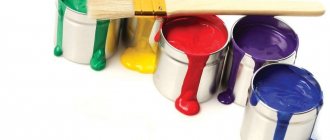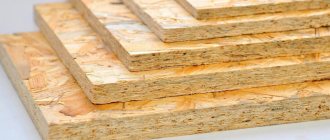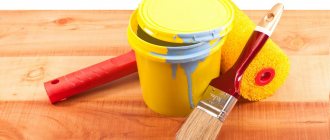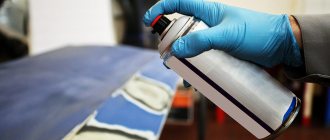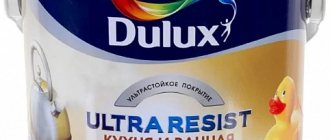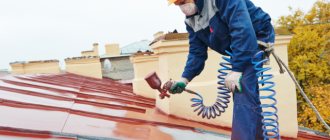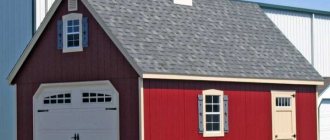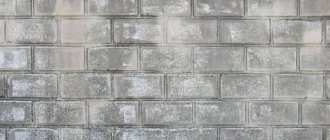To increase durability and protect metal surfaces from external factors, it is necessary to perform additional processing of the material. Metal paint can be used for this. It is especially effective if it is necessary to change the external design of the structure. There are different types of coloring compounds that have certain characteristics. Before using enamel, you need to study its features and application rules.
Metal paint
Varieties
There are various coloring compositions on sale. They differ in properties and operating conditions. Before buying enamel, you need to study its features and properties.
Powder
They are used by large enterprises for processing parts from machine tools, machines, household appliances, and other products. Advantages:
- maintaining the integrity of the layer at temperatures from -60 to 150 °C;
- resistance to moisture;
- creating a durable coating that is resistant to mechanical damage;
- environmental friendliness;
- reliability.
Powder coating of metal requires special equipment, which can only be used in sealed capsules.
Powder coated parts (Photo: Instagram / wild_color_nvrsk)
Oily
Made on the basis of drying oil. Advantages:
- environmental friendliness;
- no unpleasant odor;
- low price.
Flaws:
- A film does not form on the metal, which protects the surface from moisture.
- The decorative coating quickly fades under ultraviolet radiation.
- Such enamels are short-lived.
Nitro
Coloring compositions are available in the form of:
- dry mixtures;
- aerosols;
- liquid solution.
Advantages of nitro paints:
- ease of removal;
- quick drying;
- low price.
Flaws:
- Poor adhesion.
- Destruction due to prolonged exposure to ultraviolet radiation.
- Big expense.
Due to their high toxicity, nitro paints are rarely used in residential areas.
Containers with nitro paint (Photo: Instagram / birgroupcompany)
Alkyd
Enamels made on the basis of pentaphthalic varnish. Advantages:
- formation of a durable protective layer;
- low price;
- durability, reliability;
- attractive look.
Flaws:
- unpleasant odor;
- high flammability of the composition.
Previously, alkyd enamels were made only for working with metal, but later they began to be used for other materials.
Steps coated with alkyd paint (Photo: Instagram / maksimfeigenberg)
Acrylic
Initially used when working with wood and concrete. They began to be used for metals relatively recently. Advantages:
- no unpleasant odor;
- durability, resistance to mechanical stress;
- ease of application;
- immunity to temperature changes and increased humidity levels.
Improved acrylic paints for metal have virtually no disadvantages.
Epoxy
Builders use epoxy enamels to protect work surfaces from exposure to aggressive liquids.
Advantages:
- high adhesion rate;
- elasticity of the coating;
- high strength;
- resistance to chemicals, high humidity, temperature changes.
Flaws:
- high price;
- toxicity of a two-component composition.
When working with epoxy paint, you must first thoroughly mix the two components and then apply the resulting mass. It is important to have time to use the composition before it hardens.
Containers with epoxy paint (Photo: Instagram / epoxneva)
Hammer
They are manufactured, but based on polymer resins. Advantages:
- filling all irregularities similar to concrete contact or primer;
- resistance to high humidity, temperature changes, exposure to sunlight;
- immunity to mechanical damage;
- attractive appearance;
- increased heat resistance.
Flaws:
- difficult removal of old coating;
- high consumption;
- high price.
Hammer compounds can be applied without preparing the wall with a primer. One of the popular types is 3-in-1 hammer paints.
Hammer paint (Photo: Instagram / altai_kirov)
Anti-corrosion
Coloring compounds can be applied without preparing the base. Advantages:
- use at temperatures from -20 to +80 °C;
- preservation of properties for 8 years.
Metal and rust paint releases harmful substances that can end up in drinking water.
Rubber
Advantages:
- the dried decorative layer protects the metal from mechanical damage and environmental factors.
- the metal becomes resistant to rust;
- The coloring composition is suitable for coating any materials.
Flaws:
- high consumption;
- high price.
Made from bitumen resin.
The best oil paints for metal
Oil base is the most common coating option. However, in the future it can only be painted with materials of similar composition. To compile the rating, 7 options were considered, but the choice settled on only 2.
Lakra MA-15
Made on the basis of linseed oil, it is ready for use. But before you start painting, the surfaces must be carefully prepared: cleaned of rust/scale, degreased, and coated with an alkyd primer. Then its service life will increase. If the consistency seems dense, then it can be brought to the “ideal” by diluting with white spirit. The consumption of such a mixture is favorable - 8 m2/kg.
Advantages
- Warranty – 18 months;
- Convenient application;
- Even 1 layer is enough;
- Affordable price.
Flaws
- Demanding on the surface.
When choosing this building material, you should pay attention to safety precautions: ventilate the premises well, avoid getting it inside or on mucous membranes.
Novocolor MA-15
A universal option for painting all surfaces. Suitable for metal, wooden products, roofs, walls. Forms a film that is resistant to abrasion and static exposure to water. However, it is very picky about the place of application. It must be clean, dry, free of dirt and rust. The mixture is ready for use; if necessary, it can be diluted with white spirit, turpentine, or drying oil to give it a more liquid consistency. Novocolor is fast drying. Even at a humidity of 70%, a fully finished appearance is achieved within 24 hours.
Advantages
- Easy to apply with any tools;
- Lays down evenly;
- Large selection of shades;
- Various volumes.
Flaws
- Short service life - 1 year.
Buyers pay attention to the fact that the composition does not contain anti-corrosion components, so this option should not be used outdoors.
Selection principles
Paint for metal surfaces should be:
- Resistant to temperature changes and heating up to 80–100 °C, high humidity levels.
- Environmentally friendly. Dried decorative coatings should not emit harmful substances when heated strongly.
- The required shade.
The enamel must provide protection to metal surfaces from rust.
Assortment of paints (Photo: Instagram / anna_shelepneva)
How to determine the quality of enamel?
To determine the quality of the paint, you need to carefully examine the container in which it is poured for defects. You also need to pay attention to its storage conditions and shelf life. After opening the jar, you need to take a closer look at the contents. There should be no large lumps, cloudiness, or multi-colored inclusions.
Manufacturers and prices
Manufacturers:
- "Tikkurila";
- "Novbytkhim";
- "Hamerite."
The average price per liter is 300 rubles.
Principles of coloring
You can paint a metal surface without practical skills. It is enough to prepare the required materials, tools, coat the working surfaces with a primer, and apply paint.
Tools and materials
To carry out painting work you need to prepare:
- set of brushes, roller;
- paint container;
- stationery knife, masking tape;
- thick polyethylene film;
- primer;
- metal brush, sandpaper.
To paint metal structures in hard-to-reach places, you need to use a brush with a long, thin handle.
Sandpaper (Photo: Instagram / abraziv.by)
Preparation
Stages of preparing metal surfaces before painting:
- Rough metal processing. This removes serious contaminants and scale.
- Surface grinding. It is necessary to sand the metal with fine-grained sandpaper.
After stripping the metal, you need to cover the surrounding surfaces with film to avoid staining.
Puttying
If the surfaces to be painted are uneven and have many depressions, they need to be puttied. To do this, you need to buy a special mixture at a hardware store and apply it according to the instructions indicated on the container.
Padding
Surface priming is necessary to increase adhesion and increase the durability of the decorative coating. It is important to choose the appropriate composition so that the decorative layer maintains its integrity for a long time.
Kinds
Types of primers:
- Inhibitory. If rust begins to form on the metal, the primer will stop the process of destruction of the material.
- Protective. Manufactured on the basis of phosphoric acid. After application, a strong, durable film is formed.
- Phosphating. Suitable for working with non-ferrous metals.
- Insulating. Manufactured on an alkyd or epoxy base. Form a durable film.
Primer for metal (Photo: Instagram / birgroupcompany)
Application principles
The principle of applying primer is simple:
- Remove any dirt and dust from the surface.
- Dilute the primer with water.
- Apply the composition using a roller. If you don't have a roller, you can use a wide brush.
Applying paint
Paint can be applied only after the primer has dried. Most coloring compounds are applied in one layer. For painting, you can use a spray gun connected to a compressor, a brush or a roller.
Safety precautions
Safety regulations:
- You should work in protective clothing, gloves, and a respirator.
- There should be no heating devices in the painting area.
- Do not use paint near open flame sources.
Girl in a respirator (Photo: Instagram / tkani_cochonnet)
How and with what to paint unprepared surfaces?
To paint unprepared surfaces, you need to use anti-corrosion coatings. Instructions can be read on the packaging. It is better to use powder paint, but this requires a special camera and appropriate equipment.
Technology: how to properly paint metal surfaces outdoors
It would seem that there is nothing complicated - take a brush and apply a layer. But a lot depends on the preparation of surfaces and the correct choice of paints and varnishes. If you choose a paint that is not suitable for a certain type of metal, it will quickly crack.
Paint for painting metal surfaces outdoors must contain anti-corrosion substances, preferably with rust converters.
How to determine the quality of metal
Most often, fences and other structures are made of black iron, which quickly rusts. To slow down the oxidation process, coat the parts with alkyd primer.
Galvanized metal parts, especially roofs, are painted with alkyd paint.
As for non-ferrous metals (for example, copper is a red metal), they are almost not painted; in extreme cases, they are coated with varnish (epoxy or polyurethane).
Sequence of work execution
If the damage is minor, before starting work, treat the metal surface with a degreasing solution, then the paint will “adhere” well and adhere to the base material.
If the metal is covered with a thick layer of rusty deposits, remove it with a special metalworking tool (scraper). Using a pointed tip, you can remove a layer up to 0.01 mm thick.
There is no need to strip everything down to the base; a thin, uniform layer of rust is acceptable.
If you don’t have a scraper, you can use sandpaper or a brush with metal teeth. A simple metal sponge is suitable for cleaning lightly damaged parts.
You can not remove the rust, but treat it with orthophosphoric acid (included in some solutions) and apply a layer of paint on top. Phosphoric acid is best used in advanced cases.
Important! Before treating metal with any chemicals, wear gloves and a respiratory mask.
After removing rust and treating parts with solvents and degreaser, wait until the structure dries. You cannot apply paint to a wet structure.
It is recommended to wash the structures with plain water and soap.
Which paint is suitable for untreated surfaces:
- The composition contains corrosion inhibitors, substances that slow down the formation of rust.
- The thickness of the protective film is at least 150 microns.
The next step after drying is priming the surface. The primer provides additional protection and enhances adhesion to the material (it is recommended to apply 2 layers).
For ferrous metal, take an anti-corrosion primer, for non-ferrous metal, a mixture with good adhesive ability or varnish.
After the primer has dried, you can begin applying paint.
The nuances of coloring
It is more convenient to paint twisted fences, fences or decorative figures made of iron with a brush - it will get into all hard-to-reach places and paint over small details.
Apply several layers (wait for the first to dry before applying the second).
The number of layers depends on how well the surface was treated and what compounds were used. If there was no pre-treatment or cleaning, then more paint will be needed.
It is easier to paint small areas with an aerosol can, the main thing is not to interrupt during application - the stream should be continuous, and the distance of the spray from the surface should not be more than 20 cm. At least 3-4 layers will be needed.
Before spraying again, you need to wait for the previous layer to dry (about 15 minutes).
It is better to paint metal surfaces over large areas (for example, roofs) with a wide, but not very hard roller. If you paint hard, you will have to go back and paint over the missed areas.
You need to add a solvent to the enamel for exterior use (10% of the volume of the jar).
The maximum number of layers is 3.
Use a roller to paint only a flat surface; corners and joints are painted separately with a brush. Dip the roller into the paint tray, press lightly against the mesh (to avoid splashing) and bring it to the wall or metal surface. The movements need to be made up and down, and the strips themselves should be placed on top of each other with a slight overlap.
Recommendations
Tips for painting metal surfaces:
- Some formulations cannot be used for drinking water containers.
- To paint stoves, you need to use enamels that can withstand heating above 500 °C.
- To prepare the surface of non-ferrous metals, you need to use special primers.
- Batteries and coils should be painted only after they have been turned off and cooled down.
Standard storage conditions for coloring compounds are 15–25 °C.
You can find different paints for metal surfaces on sale. They have certain features, strengths and weaknesses that need to be taken into account when working with them.
